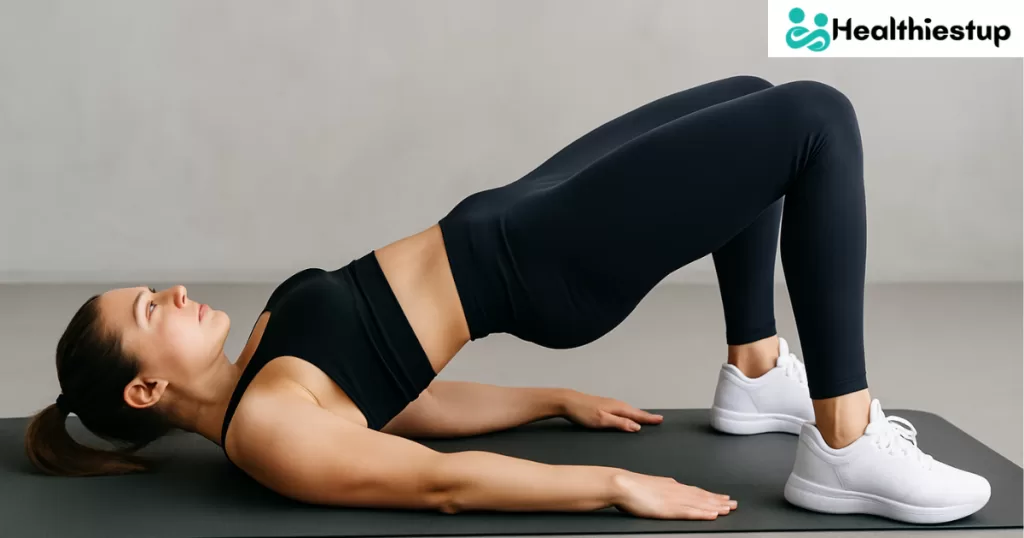Introduction
The glutes short for gluteal muscles are among the largest and most powerful muscles in your body. They play a central role in hip movement, pelvic stability, posture, athletic performance, and injury prevention. However, due to prolonged sitting and modern sedentary lifestyles, many people suffer from “gluteal amnesia” a condition where the glutes essentially forget how to fire properly. This not only reduces performance but increases the risk of lower back pain, tight hip flexors, and poor posture. The good news? With proper glute activation exercises, you can reawaken and strengthen these muscles effectively.
This article will dive deep into what glute activation is, why it’s essential, and the best glute activation exercises you can incorporate into your warm-up or training routine to ensure your glutes are fully engaged and ready for action.
What Is Glute Activation?
Glute activation is the process of “waking up” your glute muscles, particularly the gluteus maximus, medius, and minimus, before engaging in a workout or activity that requires lower body movement. When your glutes are properly activated, they contract efficiently and provide the power needed for squats, lunges, deadlifts, running, and jumping.
Due to inactivity or incorrect movement patterns, other muscles—like the lower back, hamstrings, or quads—often take over the role of the glutes, leading to muscle imbalances and potential injuries. Activation drills correct these imbalances and ensure optimal glute function.
Benefits of Glute Activation
-
Enhanced performance: Strong, activated glutes improve your ability to sprint, lift, jump, and move with power.
-
Injury prevention: Proper activation reduces the load on your lower back, knees, and hips by evenly distributing force.
-
Better posture and balance: Strong glutes help maintain proper spinal alignment and pelvic positioning.
-
Improved aesthetics: Consistent activation and training help tone and shape your glutes over time.
Signs Your Glutes Are Not Firing Properly
If you experience any of the following, it could be a sign your glutes are inactive:
-
Tight hip flexors and hamstrings
-
Lower back pain during workouts
-
Limited hip mobility
-
Dominant quadriceps during squats or lunges
-
A flat or sagging butt appearance
Recognizing these signs is the first step toward corrective action through targeted activation.
|Also Read: Powerful Skull Crushers Benefits & How to Do Them Properly
Best Glute Activation Exercises
Below are the most effective exercises to switch on your glutes. These should ideally be done before your main workout or even on rest days for rehabilitation purposes. Perform each movement for 2–3 sets of 12–20 reps or 30–60 seconds.
1. Glute Bridges
How to do it:
-
Lie on your back with your knees bent, feet hip-width apart, and flat on the ground.
-
Squeeze your glutes and lift your hips until your body forms a straight line from shoulders to knees.
-
Hold at the top for 2–3 seconds before lowering slowly.
Why it works: Glute bridges isolate the gluteus maximus while minimizing lower back strain. It’s perfect for beginners and easy to progress.
2. Clamshells

How to do it:
-
Lie on your side with knees bent and feet together.
-
Keeping your feet touching, open your knees like a clamshell while keeping your hips stacked.
-
Pause, then return to the start.
Why it works: This targets the gluteus medius, a crucial stabilizing muscle often neglected.
3. Fire Hydrants
How to do it:
-
Start in a quadruped (all fours) position.
-
Lift one knee out to the side while keeping it bent at 90 degrees.
-
Hold for a second at the top, then lower.
Why it works: This dynamic movement strengthens both gluteus medius and minimus, enhancing hip stability.
4. Banded Lateral Walks
How to do it:
-
Place a resistance band around your thighs or ankles.
-
With a slight squat, take small steps sideways while keeping tension in the band.
Why it works: Lateral walks challenge gluteus medius and minimus, improving lateral stability and movement control.
5. Donkey Kicks
How to do it:
-
Start on all fours and kick one leg up and back while keeping it bent.
-
Squeeze your glute at the top, then return.
Why it works: Donkey kicks activate the gluteus maximus in isolation and are easy to perform with added resistance.
6. Hip Thrusts

How to do it:
-
Sit with your upper back against a bench and barbell over your hips (or bodyweight for beginners).
-
Drive through your heels to lift your hips, squeezing the glutes at the top.
Why it works: Arguably the king of glute-building exercises, hip thrusts ensure deep gluteal activation and muscle engagement.
7. Step-Ups
How to do it:
-
Use a sturdy bench or box.
-
Step up with one foot and drive through your heel to lift your body, then step down.
Why it works: Functional and effective, step-ups simulate real-life movement while engaging all glute muscles.
Tips for Effective Glute Activation
-
Prioritize mind-muscle connection: Focus mentally on squeezing your glutes during every rep.
-
Slow down your reps: Control the tempo to ensure the glutes are doing the work, not momentum.
-
Use mini-bands: Resistance bands increase muscle tension and amplify activation.
-
Activate before lifting: Perform these drills before leg day or sprint sessions for best results.
-
Stay consistent: Make glute activation a regular part of your warm-up routine.
Common Mistakes to Avoid
-
Using too much weight too soon: Activation is about engagement, not max load.
-
Arching the back: This shifts tension away from the glutes and onto the lower spine.
-
Rushing through reps: Slow, deliberate movements activate muscles more effectively.
-
Ignoring weaker sides: If one glute is less active, perform extra reps or isolated work on that side.
When to Do Glute Activation Workouts
-
Before lower-body workouts
-
After long periods of sitting
-
As part of rehab for lower back or hip issues
-
On rest days as a recovery protocol
Long-Term Strategy for Glute Growth and Performance
Glute activation is not just a warm-up trend—it’s foundational. Incorporating these movements into your routine enhances every lower-body workout. Once your glutes are firing, compound lifts like squats, deadlifts, and lunges become more effective, safer, and more rewarding. Over time, consistent glute activation paired with progressive overload training leads to visible muscle development, better athletic function, and injury resistance.
Conclusion
Glute activation exercises: Activating your glutes is a game-changer for both fitness and overall health. Whether you’re a seasoned athlete or a beginner, incorporating glute activation exercises like bridges, clamshells, and banded walks ensures your muscles are firing correctly, reducing injury risk and enhancing performance. By making these movements a regular part of your warm-up routine, you’ll not only build stronger, more functional glutes but also improve posture, stability, and lower-body strength. Start small, stay consistent, and let your glutes do the work they were built for.
FAQs
Q1: How long should a glute activation session last?
5 to 10 minutes of targeted movements are usually enough to prepare your glutes for more intense training.
Q2: Can I do glute activation every day?
Yes. Low-intensity glute activation can be performed daily, especially if you sit for long periods or are correcting muscle imbalances.
Q3: Do I need equipment for glute activation?
No. Most exercises are bodyweight-friendly. However, resistance bands can enhance the intensity and effectiveness.
Q4: Why do I feel glute exercises in my quads or hamstrings?
This often means your glutes aren’t firing properly yet. Reduce weight, slow down your reps, and focus on form and mind-muscle connection.
Q5: Will glute activation help with lower back pain?
Yes. Proper glute engagement reduces overcompensation by the lower back, often alleviating chronic discomfort.



